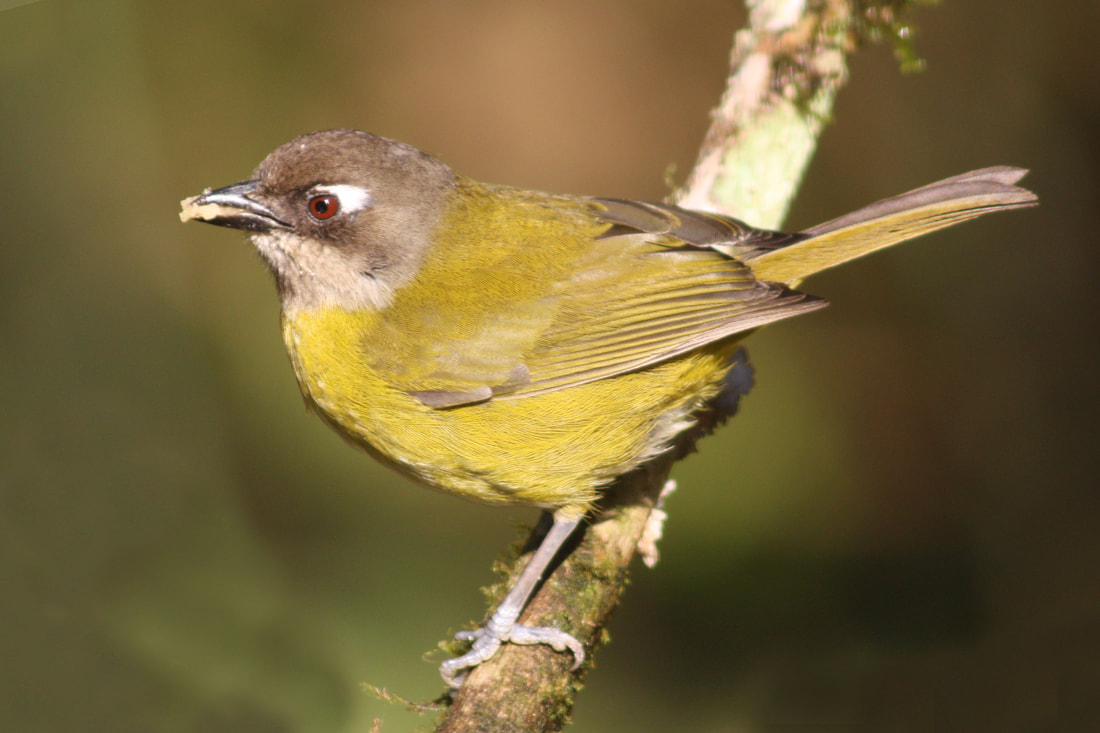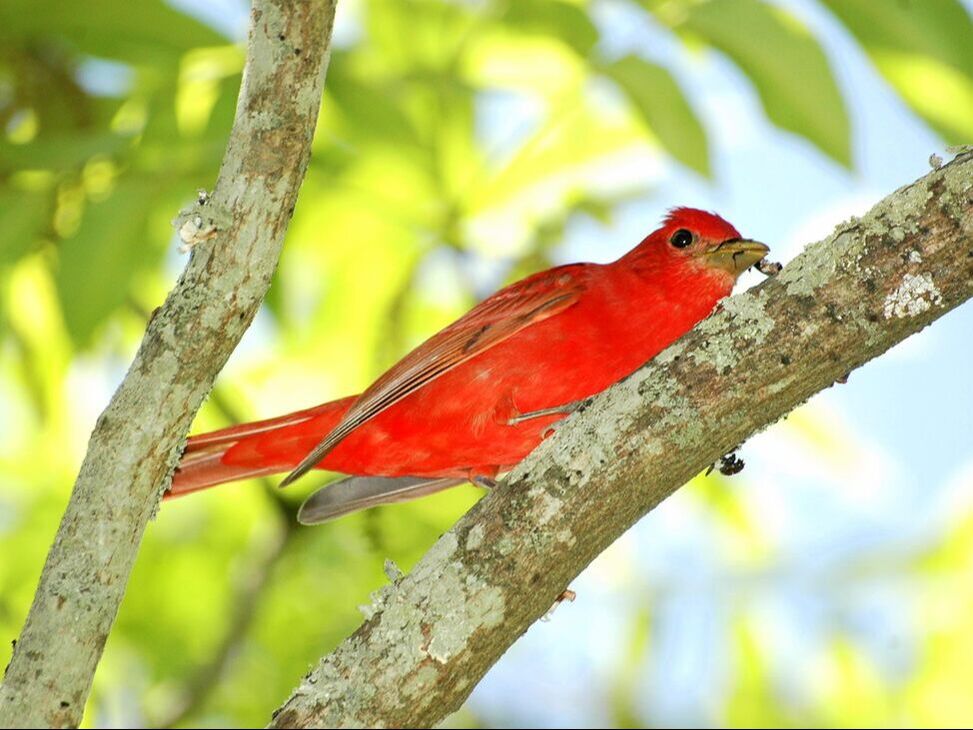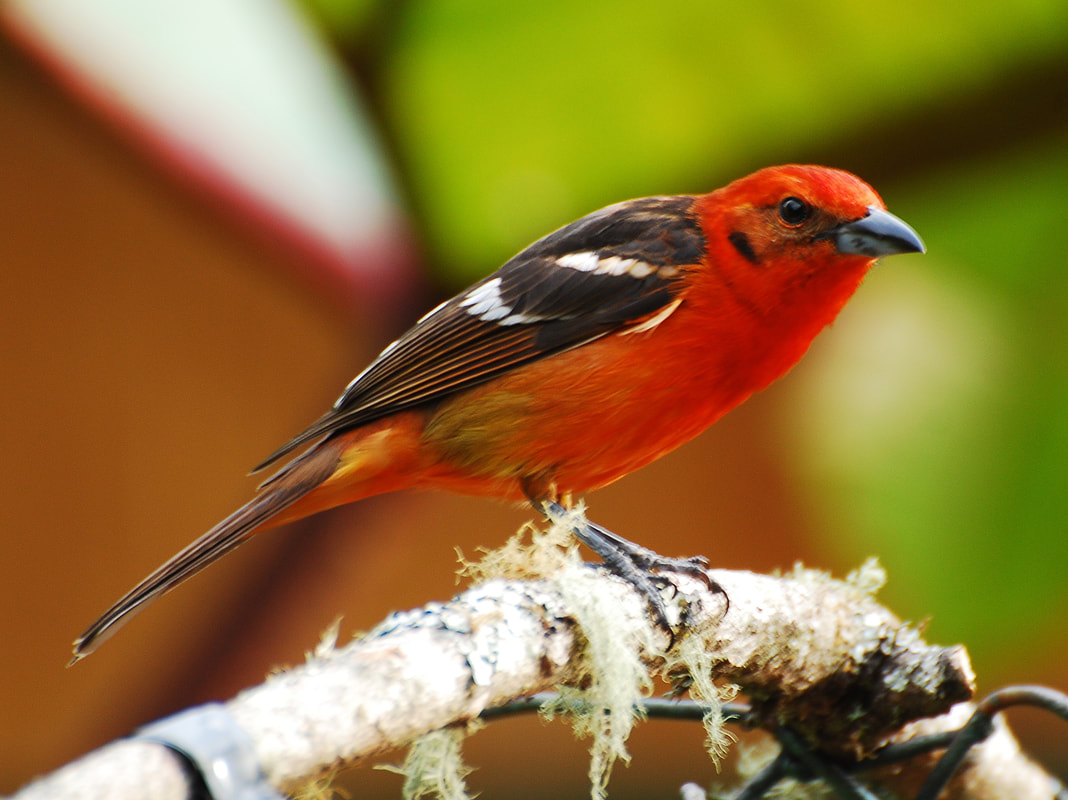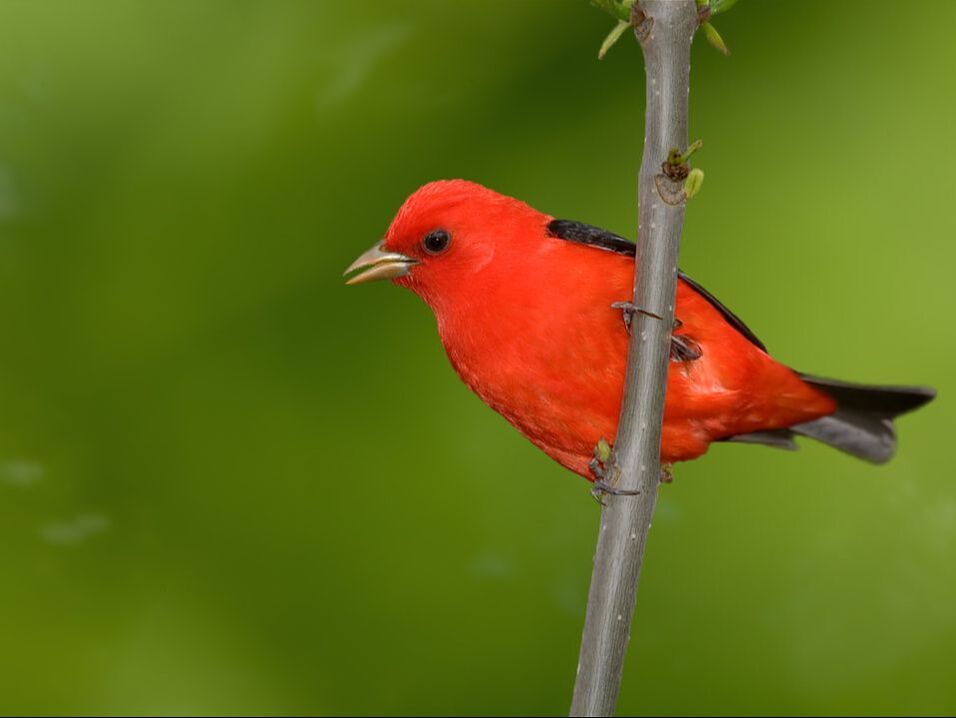Tanagers - in Belize
Common Bush Tanager
Common Bush Tanager
BELIZE HABITAT - Midlevels to canopy; submontane broadleaf forest interior and edge. Where can I find this bird in Belize? Very common resident above 2,300 feet in Maya Mountains of Cayo, Stann Creek and Toledo. |
Blue-Gray Tanager
Blue Gray Tanager - Common and widespread powder blue-gray bird of open and semi-open areas with larger trees and hedges, towns, villages, and gardens in tropical and subtropical regions. Mainly feeds at mid-upper levels in trees, eating fruit, and perches readily on phone wires. Rather plain but distinctive appearance, with beady dark eye and fairly stout bill. Populations east of the Andes in South America have broad white wing-bars and look very different.
BELIZE HABITAT - Midlevels to canopy open areas with scattered trees, towns and villages, parks, orchards, forest edge. Frequents fruiting trees. Where can I find this bird in Belize? Common resident on mainland, increasingly less common northward, becoming scarce in north Orange Walk and Corozal. Occasionally seen on Ambergris Caye. |
Yellow-Winged Tanager
Yellow Winged Tanager - Fairly common in tropical lowlands and foothills, favoring forest edge and woodland, as well as semi-open areas such as towns and gardens with larger trees. Mainly feeds at mid-upper levels in trees, eating fruit, and perches readily on phone wires. Often appears rather dull, but yellow square on black wings is a good field mark; in good light, lilac plumage tones can be appreciated. Often in the same areas as Blue-gray Tanager, and the calls of the two species are also rather similar.
BELIZE HABITAT - Subcanopy and canopy; forest edge; open areas with scattered trees; towns and villages. Frequents fruiting trees. Where can I find this bird in Belize? Common resident on mainland north locally to south Corozal. |
Rose-Throated Tanager
Rose Throated Tanager - Uncommon in tropical woodland and forest edge of Yucatan Peninsula, mainly at mid-upper levels where often quite and overlooked easily. Usually seen singly or in pairs. Rather plain, despite the name. Grayish overall with a broken white eye-ring; male has a rose-pink throat and red wash to the crown, wings, and tail; on the female these areas are washed yellowish.
BELIZE HABITAT - Subcanopy and canopy; deciduous and semi-deciduous seasonally flooded broadleaf forest interior. Where can I find this bird in Belize? Uncommon to locally fairly common resident on mainland south to north Cayo and central Belize. One record each for Shipstern Caye and Ambergris Caye. |
Gray-Headed Tanager
Gray Headed Tanager - Small, uncommon tanager of humid tropical lowland forest, sometimes found at army ant swarms. Typically inhabits low to mid-levels of shady understory, as singles or pairs. Sexes look alike, with bushy gray head cleanly cut off from the rich yellow underparts and olive-green upperparts. Song is a rich squeaky warble, at times prolonged.
BELIZE HABITAT - Understory and low-level strata; broadleaf forest interior and edge. Where can I find this bird in Belize? Uncommon to common resident at low and mid-elevations on mainland. |
Red-Crowned Ant Tanager
Red Crowned Ant-Tanager - Fairly common in middle level understory of tropical and subtropical forests and woodlands. Usually in small groups, mainly comprising female-plumaged birds. Associates readily with similar Red-throated Ant-Tanager when attending army ant swarms. These two species are best told by voice: high squeaky calls in Red-crowned and low rasping calls in Red-throated. Also, Red-crowned tends to forage at higher levels and its plumage is slightly paler and plainer than Red-throated, without a contrasting dark mask (male) or buffy throat (female).
BELIZE HABITAT - Understory to sub-canopy; broadleaf forest interior and forest edge. Where can I find this bird in Belize? Uncommon to fairly common resident at lower elevations in interior, common at higher elevations, north to south and east Cayo and southwest Belie: also in northwest Cayo, west and central Orange Walk, and locally in east and northeast Orange Walk. May be absent in Corozal. |
Red-Throated Ant Tanager
Red Throated Ant-Tanager - Fairly common in the understory of lowland tropical forest and woodland; also ranges into adjacent secondary growth. Usually in small groups, mainly comprising female-plumaged birds. Associates readily with similar Red-crowned Ant-tanager when attending army ant swarms. These two species are best told by voice: low rasping calls in Red-throated, high squeaky calls in Red-crowned (remember: the throat is lower than the crown). Male Red-throated has a small dark mask between the eye and the bill, and female has a contrasting buff throat.
BELIZE HABITAT - Understory and mid-levels; broadleaf forest interior and forest edge. Where can I find this bird in Belize? Common to very common resident on mainland; least common at higher elevations, where it is out-numbered by Red Crowned. |
Black-Throated Shrike
Black Throated Shrike Tanager - Uncommon inhabitant of humid evergreen forest in tropical lowlands. Found singly or in pairs, typically perched quietly and rather upright at middle to upper levels inside the forest. Often with mixed-species feeding flocks acting as a sentinel, giving alarm calls when a hawk or other predator appears. Striking black-and-yellow male suggests an oriole in pattern, but note stout bill. Female much duller, with grayish head and stout bill.
BELIZE HABITAT - Sub-canopy and canopy; mature broadleaf forest interior. Where can I find this bird in Belize? Uncommon to common resident in interior north to south and east central Cayo; also in west Orange Walk and locally along New River in east Orange Walk. |
Crimson-Collared Tanager
Crimson Collared Tanager - Beautiful tanager of humid tropical lowlands. Favors evergreen forest edge and verdant second growth. Forages unobtrusively at all levels in trees and bushes, usually in pairs. Sexes alike: velvety black overall with a bright bluish-white bill and a glossy crimson collar and rump.
BELIZE HABITAT - Second growth scrub, roadside brush and tangles. Where can I find this bird in Belize? Fairly common resident on mainland north to south east Orange Walk and Stann Creek Belize; reported once on Ambergris Caye. |
Hepatic Tanager
Hepatic Tanager - Large tanager with several different populations, spanning the southwest U.S. to South America. Northern birds prefer mountainous areas with mixed pine-oak forest. South American birds found in a variety of mountainous forested habitats. Male red, female muted yellowish. Brightest colors on throat and crown. Flanks, cheek, and back washed with dusty gray. Thick bill. Most similar to Summer Tanager, but grayer plumage. Also typically found at higher elevations with conifers, not in low riparian woodland preferred by Summer. Song is sweet and robinlike; mostly clear phrases with some hoarser notes.
BELIZE HABITAT - Sub-canopy and canopy; pine forest. Where can I find this bird in Belize? Common resident in coastal lowlands from central Belize to north east Toledo and in Mountain Pine Ridge; inexplicably scarce in seemingly suitable habitat in north Belize and east Orange Walk. |
Summer Tanager
Summer Tanager - Adult males are completely red; immature males are dull yellow with blotchy patches of red. Females are variable, ranging in color from pale dull yellow to brighter orange. In both sexes, note longer, paler bill than Scarlet Tanager. Breeds in wooded areas, ranging from pine-oak forests in the southeastern U.S. to riparian corridors in northern Mexico and western U.S. Winters in Central and South America.
BELIZE HABITAT - Midlevels to canopy; broadleaf and pine forest interior and edge; oepn country with scattered trees. Frequents fruiting trees. Where can I find this bird in Belize? Common winter visitor, early September to mid-May. |
Flame-Colored Tanager
Flame Colored Tanager - Fairly common in oak and pine-evergreen forests in foothills and highlands; a few descend in winter to lowlands of west Mexico. Forages mainly at middle to upper levels where often quiet and overlooked easily. Note the bold white wingbars, big white tertial and tail spots, and dark streaks on back. Male flame-orange in west Mexico and deeper orange-red in east Mexico and Central America. Female told from female Western Tanager by gray bill, bolder white wing markings, and streaked back. Calls and song very like Western Tanager.
BELIZE HABITAT - Midlevels to canopy; montane broadleaf forest. Where can I find this bird in Belize? Small resident population above 3,000 feet elevation on Mountain Margaret Cayo. |
Western Tanager
Western Tanager - Adult males are bright yellow with black back and red head. Females are dull yellow with grayish wings and two yellow wingbars. Breeds mainly in coniferous forests at higher elevation. Often high in trees; listen for male's burry song. Winters in Central America.
BELIZE HABITAT - Midlevels to canopy; forest interior and edge; frequents fruiting trees. Where can I find this bird in Belize? Few records, mostly undated and none fully documented. Recorded in Orange Walk, Belize and Toledo. |
Scarlet Tanager
Scarlet Tanager - Adult males are brilliant red with black wings and tail. Females and nonbreeding males are dull yellow-olive with gray or black wings. Breeds in forested areas. Song is burry series of notes, like a robin with a sore throat. Winters in South America. Occasionally visits feeders in the spring, especially after periods of rain. Prefers oranges or grape jelly.
BELIZE HABITAT - Subcanopy and canopy; broadleaf forest interior and edge. Where can I find this bird in Belize? Common autumn transient and fairly common spring transient, mid-September to late October and late March to early May. |
White-Winged Tanager
White Winged Tanager - Fairly small tanager of humid evergreen and pine-oak forest in foothills and highlands. Found mainly in the canopy, usually in pairs or small groups that sometimes join mixed-species feeding flocks. Distinctive male is brilliant red with black mask and black wings with neat white wingbars. Female has same plumage pattern as male but is greenish and yellow overall. Calls are high lisping whistles.
BELIZE HABITAT - Midlevel; montane and foothill broadleaf forest edge. Where can I find this bird in Belize? Fairly common resident at mid and high elevations in Maya Mountains, Vaca Plateau Cayo, and broadleaf forest within Mountain Pine Ridge; uncommon and perhaps seasonal in west interior Cayo and Orange Walk. |
Passerini's Tanager
Passerini's Tanager
BELIZE HABITAT - Second growth scrub, roadside brush and tangles. Where can I find this bird in Belize? Common resident on mainland north to southeast Orange Walk and central Belize. |
Bananaquit
Bananaquit - Tiny, active, warbler-like bird of tropical and subtropical forest edge, woodland, and gardens. Feeds on nectar and fruit, and in some areas (especially the Caribbean) visits bird feeders. Note the bold white eyebrow, slightly decurved bill, and yellow underparts. Throat color varies from pale gray on mainland (Mexico to South America), to white on some island populations (including Cozumel).
BELIZE HABITAT - Midlevels to canopy, broadleaf forest interior and edge. Where can I find this bird in Belize? Uncommon to locally fairly common resident in lowlands and very common resident in Maya Mountains, north to north east Cayo and central Belize. Fairly common resident on Ambergris Caye and common resident on Caye Caulker. Caboti was unknown in Belize prior to the 1980's. It may have recently colonized Ambergris Caye and Caye Caulker from farther north or it may have been previously overlooked. |
Golden-Hooded Tanager
Golden Hooded Tanager - Very attractive small tanager of humid tropical lowlands. Found in humid evergreen forest edges, plantations, and gardens; at times with mixed-species feeding flocks of honeycreepers and euphonias. Often in pairs, feeding at all levels in fruiting trees and bushes. Sexes look alike: black and blue overall with a white belly and a soft golden hood; in good light, varied purple and turquoise sheens are apparent.
BELIZE HABITAT - Canopy and subcanopy; pine and broadleaf forest interior and edge. Where can I find this bird in Belize? Fairly common to common resident north to south west Orange Walk, north east Cayo, and south west Belize; also locally in east Orange Walk. |



















